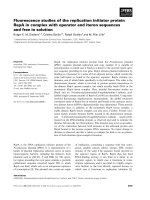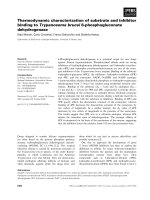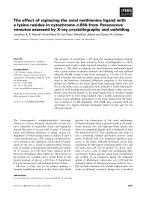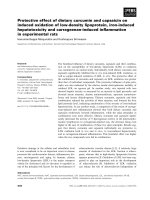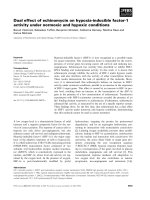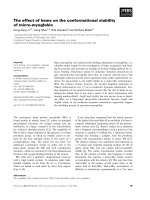Báo cáo khoa học: "Prophylactic effect of plaster and cataplasm contained ketoprofen in rats with adjuvant arthritis" pot
Bạn đang xem bản rút gọn của tài liệu. Xem và tải ngay bản đầy đủ của tài liệu tại đây (970.78 KB, 6 trang )
9HWHULQDU\
6FLHQFH
J. Vet. Sci. (2001), 2(1), 65–70
Prophylactic effect of plaster and cataplasm contained ketoprofen in rats
with adjuvant arthritis
Seong-Soo Kang and Seok-Hwa Choi*
Department of Surgery, College of Veterinary Medicine and Research Institute of Veterinary Medicine,
Chungbuk National University, Cheongju 361-763, Korea
This study demonstrates that prophylactic effect of
plaster and cataplasm contained ketoprofen in adjuvant
arthritis therapy by X-ray. Adjuvant arthritis was
induced by a single injection of Freund's complete adju-
vant. Mature female Sprague-Dawley rats were desig-
nated to 3 groups such as nontreated control, plaster-
treated (PT) and cataplasm-treated (CT), each of which
was composed of ten animals. The PT and the CT groups
showed reduced primary paw swelling, but secondary
paw swelling was not affected. Bony changes were
observed in all regions of the femur and tibia of the non-
adjuvant-injected leg and the adjuvant-injected leg. The
mean radiographic scores of the PT and the CT groups
were significantly lower than those of the control group
from day 0 to 7 of the experimental period (P<0.05,
P<0.01). The CT rats showed reduced poly-arthritis devel-
opment than the PT rats. Our results suggest that radio-
graphic assessment of bony changes is more suitable for
measuring changes in long bones such as femur or tibia
than in vertebrae. The prophylactic effect of CT promi-
nently suppressed edematous swelling and bony changes
in arthritic limb compared with PT.
Key words:
Adjuvant arthritis, plaster, cataplasm, ketoprofen.
Introduction
Arthritis in rat induced by intradermal injection of
mycobacterial adjuvant is widely used as a model for the
evaluation of compounds with anti-inflammatory or anti-
rheumatic activity [22]. While the clinical appearance of
the arthritis has been described, less is known about the
time course of the concomitant bone damage [9]. There
has also been some a speculation as to the prophylactic
effects of plaster and cataplasm contained ketoprofen in
suppressing the effects of adjuvant arthritis.
Nonsteroidal anti-inflammatory drugs (NSAIDs) are
effective depressors of bone resorption [10,18]; in particu-
lar the aryl propionic acid class seems to be the most effec-
tive class of NSAIDs at preventing bony loss
in vivo
osteopenic models with very little interruption of bone for-
mation [21]. Ketoprofen is a potent non-steroidal anti-
inflammatory drug that is used for the treatment of rheu-
matoid arthritis. However, the oral administration of keto-
profen can cause gastric irritation and renal adverse effects.
Earlier studies using this model for the study of arthritic
bone erosion were limited to histological evaluations and
measurements of the urinary excretion of pyridine and/or
deoxypyridine [3,15]. However, little information is avail-
able on the quantitative changes of corticol and trabecular
bones during the development of adjuvant arthritis. The
loss of trabecula bone is greater and faster that of the than
cortical bone [16,19]. Therefore it is important to compare
the response of a variety of skeletal sites. There are no data
on the bony changes which occur during the development
of adjuvant arthritis. The aim of this study was to investi-
gate the changes in the cortical and trabecular bones during
the development of adjuvant arthritis by X-ray.
Materials and Methods
Animals
Mature female Sprague-Dawley rats (KRICT, Taejon,
Korea), 6 weeks of age at the time of adjuvant injection,
were used forth study. Five rats were housed per cage (43
×
27
×
18 cm) in an air-conditioned environment (room tem-
perature 23
±
2
o
C, humidity 55
±
5%) that was illuminated
from 6 : 30 to 18 : 30. Animals were fed with a commer-
cial diet (Samyang feed Co., Korea), and divided into three
groups, plaster-treated (PT), cataplasm-treated (CT) and a
non-treated control, each group was composed of ten ani-
mals. Adjuvant-arthritis was treated with plaster (X Co.,
Korea) and cataplasm (Y Co., Korea) containing 15 mg of
keptoprofen at a site on the back twice a day (half day) for
5 days 1 hour prior to the adjuvant injection.
*Corresponding author
Phone: +82-43-261-3144; Fax: +82-43-261-3224
E-mail:
66 Seong-Soo Kang and Seok-Hwa Choi
Induction of arthritis
On day 0, each rat was injected in the plantar region of
the right hind limb with Freund's complete adjuvant (Gib-
cobrl, USA, Lot No. 1020159) containing 0.6 mg of
Myco-
bacterium butyricum
(Difco, USA, Lot No. 138137LA)
suspended in 0.1 ml of paraffin oil.
Measurements of foot size
Foot volumes of the injected (right hindpaw) and non-
injected (left hindpaw) paws were measured up to a mark
made on the tibiotarsal joint by using a messcylinder.
Clinical assessment of arthritis
Every week after the first immunization and during the
entire following up period (28 days), clinical assessments
were performed under blind conditions using the previ-
ously described scoring system [14]. The severity of arthri-
tis was graded on a 0-4 scale as follows: 0 = normal; 1 =
swelling and/or redness in 1 joint; 2 = swelling and/or red-
ness in >1 joint; 3 = swelling and/or redness in the entire
paw; and 4 = deformity and/or ankylosis. Each paw was
graded, and the 4 grades were summed to a maximum pos-
sible score of 16.
Radiographic assessment of bony changes
Radiographic changes were assessed under the blind
conditions using the previously described scoring system
[14]. Each limb was assessed for osteopenia and bony ero-
sions and graded from 0 to 3 as follows: 0 = no change; 1 =
slight change; 2 = moderate change; and 3 = severe
change. Each paw was graded, and the 4 scores were
summed up to a maximum possible score of 12.
This was performed using an X-ray unit (BLD-15RK,
Dong-A X-ray, Co., Korea). Exposure was 51 kVp and 7.5
mAs with diagnostic film (medium speed, Kodak Co,
USA) of 14"
×
14". Rats were anesthetized with xylazine
HCl (0.1 mg/kg, i.m.) and ketamine HCl (0.2 mg/kg, i.m.)
prior to X-raying. Whole bodies were X-rayed using a 90
o
projection from the dorsal-ventral aspect.
Changes of trabecular and cortical bone
Bony changes of the femur, tibia and vertebra (first sac-
ral and third coccygeal vertebrae) were assessed blind
using a previously described scoring system [11], and
graded from 0 to 3 as follows: 0 = no lesions; 1 = slight
osteoporosis; 2 = pronounced osteoporosis and slight bone
erosion; 3 = massive osteoporosis and erosion.
We selected these bones is to reflect the differences in
the change of the arthritis process in the trabecular and cor-
tical bones. Femur and tibia are composed of trabecular
and cortical bones, whereas the vertebrae are mainly com-
posed of trabecular bone [16].
Statistical analysis
All results were expressed as the mean
±
standard error
of the mean. The statistical significance of differences was
assessed by the unpaired two-tailed Student's
t-
test; P val-
ues of <0.05 were considered significant.
Results
In the control animals, the adjuvant-injected foot
showed primary inflammation on day 3 after adjuvant
injection. On day 21, the increase of paw volume peaked
250%, which persisted until the end of experiment. On the
other hand, the non-injected foot showed a 200% increased
paw volume on day 13 after injection (Fig. 1). The PT and
the CT groups showed reduced primary paw swelling but
secondary paw swelling was unaffected.
As shown in Fig. 2, the clinical arthritis score of the con-
trol rats increased until the end of experiment. Little differ-
ence was evident between the effect of CT and PT until
day 7 after the adjuvant injection. After day 7, the CT
seemed to be the more effective in the non-injected paw.
Fig. 1. Changes of paw edema by injection of adjuvant in the control (
●
), plaster- (
■
) and cataplasm-treated (
▲
) groups (n = 10).
*p<0.05, compared to the control group.
Prophylactic effect of plaster and cataplasm contained ketoprofen in rats with adjuvant arthritis 67
Radiographic assessment of bone changes
As shown in Fig 3, the X-ray score of the PT and CT
rats were significantly lower than the controls rat from day
0 to 7 of the experimental period (p<0.05, p<0.01) and CT
showed a significant difference compared with the control
until the end of the experiment (p<0.05). The CT reduced
the development poly-arthritis more so than PT.
Changes of trabecular and corical bones
During the experimental period, there were bony
changes were observed in all the regions of the femur and
tibia of the non-adjuvant-injected leg as well as the adju-
vant-injected leg, especially in the distal region.
Femur
A significant decrease was observed on days 21 and 28
in the adjuvant-injected leg of the PT and the CT groups
(p<0.05). The non-injected leg than the injected leg
showed a smaller and a more delayed decrease in the
development of bone loss and erosion than the injected leg.
Only the distal region of femur in the PT group was signif-
icantly lower than the control in the development of bone
loss and erosion on day 28 (p<0.01, Fig 4).
Tibia
The distal tibia in both injected (p<0.01) and non-
injected legs (p<0.05) showed a significant decrease in the
PT and the CT groups after day 28 (Fig 5).
Vertebrae
The first sacral vertebra showed a significant decrease in
the development of bone loss and erosion in the PT and the
CT groups after day 21 compared with the control. The
third coccygeal vertebra showed decrease an adjuvant
arthritis in PT and CT when compared with the control in
the development of bone loss and erosion, they was not
significant (Fig 6).
Discussion
Adjuvant-induced arthritis in rats has been widely used
as a model for polyarthritis such as rheumatoid arthritis
[6]. To evaluate the anti-arthritic activities, we investigated
the prophylactic effects of plaster and cataplasm contained
Fig. 3.
X-ray changes of adjuvant arthritis in the control (
●
),
plaster- (
■
) and cataplasm-treated (
▲
) groups (n=10). *p<0.05,
**p<0.01 compared to the control group.
Fig. 2.
Clinical arthritis score changes of adjuvant arthritis in the
control (
●
), plaster- (
■
) and cataplasm-treated (
▲
) groups
(n=10). *p<0.05, **p<0.01 compared to the control group.
Fig. 4.
Time course of changes in the adjuvant arthritis of the distal regions of the femur in the control (
●
), plaster- (
■
) and cataplasm-
treated (
▲
) groups (n=10). *p<0.05, **p<0.01 compared to the control group.
68 Seong-Soo Kang and Seok-Hwa Choi
ketoprofen on adjuvant-arthritis. In the present study, CT
and PT compared with the control prominently suppressed
swelling and bony changes in the arthritic limbs. It has
been reported that ketoprofen has a potent anti-inflamma-
tory action, but oral administration causes gastric mucous
membrane disturbances [5].
Recently, plaster and cataplasm contained ketoprofen
have been evaluated to determine their clinical effects on
anti-arthritis because topical ketoprofen treatment circum-
vented gastrointestinal disturbances. In an attempt to
improve the skin penetration of ketoprofen, various trans-
dermal formulations have been prepared [8].
The PT and CT rats showed less primary paw swelling
in the adjuvant injected and non-injected paws than the
control, but secondary paw swelling was unaffected. The
score of clinical arthritis in the controls rat showed
increases until the end of the experiment. However, the
mean scores of the PT and CT rats were lower than the
controls rat during the experimental period.
The radiological scores of the PT and CT rats were sig-
nificantly lower than the control rats from day 0 to 7. The
CT reduced the development of poly-arthritis more so than
PT. During the experimental period, the main radiological
changes were osteoporosis, erosion and osteal reaction in
the tarsal, metatarsal, distal regions of the tibia and the
femur, which were visible after day 14, especially in the
injected hind paw, as mentioned Blackham et al [2]. In the
case of CT, the mean arthritis score was shown to signifi-
cantly reduce from day 7 to the end of experiment. The PT,
however, showed no significant bone changes except at
day 7, which means that the CT is more effective than PT.
Bony changes were observed in all regions of the femur
and the tibia of the nonadjuvant-injected legs as well as the
adjuvant-injected legs. In the femur, a significant decrease
occurred on days 21 and 28 in the adjuvant-injected leg of
the CT and the PT rats. Only the distal region of the femurs
in the PT group were significantly decreased compared
with the controls on day 28. The distal tibia from both
injected and non-injected legs showed significant decrease
in the CT and PT groups on day 28 when compared with
the control. Trabecular bone has a larger surface area and a
faster turnover than cortical bone, which could account for
the present observation [12,17,19]. We hypothesize that the
proximal and distal regions of femur and tibia are com-
Fig. 5.
Time course of changes in the adjuvant arthritis of the distal regions of the tibia in the control (
●
), plaster- (
■
) and cataplasm-
treated (
▲
) groups (n=10). *p<0.05, **p<0.01 compared to the control group.
Fig. 6.
Time course of changes in the adjuvant arthritis of the first sacral (left) and third coccygeal (right) vertebrae in the control (
●
),
plaster- (
■
) and cataplasm-treated (
▲
) groups (n = 10). *p<0.05, **p<0.01 compared to the controls.
Prophylactic effect of plaster and cataplasm contained ketoprofen in rats with adjuvant arthritis 69
posed primarily of trabecular bone.
Our findings indicate that the bony changes occurred
after paw volumes had increase. In general, increased paw
volume in the injected hind paw represents a primary
inflammatory phase, which appeared from day 3 to 10
after adjuvant injection [16]. In the non-injected hind paw,
the inflammation is of the later chronic nature [1,20]. The
late-phase inflammation is associated with decreased bone
mineral density induced by physiological response regu-
lated by the parathyroid hormones, calcitonin, or vitamin
D. However, recently it was reported that generalized bone
loss associated with inflammation occurred independently
of these hormones in rat [7]. Another factor is the inflam-
matory cytokines, which have been found at elevated levels
in arthritic patients [13]. Inflammatory cytokines such as
IL-1, IL-6, and TNF-
α
are potent inducers of bone resorp-
tion [4]. It is possible that these cytokines mediate both the
increase of paw volume and the reduced bone density [16].
We observed significant decreases in the development of
bone loss and erosion in CT and the PT after day 21 in the
first sacral compared with the control. However, the third
coccygeal vertebra showed decrease adjuvant arthritis in
the CT and the PT when compared with the control, but
this was not significant. Takagi et al [16] reported that the
sacral and coccygeal vertebrae showed significant
decreases in bone mineral density on day 21. In the present
study, trabecular bone changes were shown to be detected
as minor bone changes because we only measured bony
changes in the first sacral and third coccygeal vertebrae
body. This method is unsuitable for measuring minor bony
changes. Radiographic assessment of bony changes is
more suitable for measuring changes in long bones such as
the femur or the tibia than in vertebrae like structures, Tak-
agi et al [16] mentioned.
In summary, the prophylactic effect of the CT and PT
prominently suppressed swelling and bony changes in all
regions of the femur, tibia and paw of the non-adjuvant-
injected leg and the adjuvant-injected leg. The CT may be
more useful clinically than the PT in the rheumatoid arthri-
tis.
Acknowledgment
This project was financially supported by grant from the
Fig. 7. Radiographs of the hind limbs of rats with adjuvant arthritis on day 28. A. Normal rat. B. Control rat; showing organized and
widespread cystic degeneration, joint subluxation and large areas of erosion with persistent severe periarticular soft tissue swelling. C.
Plaster-treated rat; showing periarticular soft tissue swelling, bony erosion, osteoporosis, periosteal reaction, and severe cystic
degeneration of the tarsals and metatarsals. D. Cataplasm-treated rat; showing periarticular soft tissue swelling, erosion and osteoporosis
of the tarsals and metatarsals, and periosteal reaction of the metatarsals. The tarsals showed mild cystic bone degeneration compare with
that of PT (C) and Control (B).
70 Seong-Soo Kang and Seok-Hwa Choi
health and medical life science project (2000R-P-5). Also,
the authors thank to Sanga Pharm. Co., Ltd. for their mate-
rial assistance.
References
1. Baumgartner, W. A., Beck, F. W., Lorber, A., Person, C.
M. and Whitehouse, W. A. Adjuvant disease in rats: Bio-
chemical criteria for distinguishing several phase of inflam-
mation and arthritis. Proc. Soc. Exp. Biol. Med. 1974, 45,
625-630.
2. Blackham, A., Burns, J. W., Farmer, J. B., Radziwonik,
H. and Westwick, J. An X-ray analysis of adjuvant arthritis
in the rat. The effect of prednisolone and indomethacin.
Agents Actions 1977, 7, 145-151.
3. Bonnet, J., Zerath, E., Picud, N., Lesur, C., Mattio, A.,
Tordjman, C., Hott, M. and Marie, P. J. Bone morphomet-
ric changes in adjuvant-induced polyarthritic osteopenia in
rats: Evidence for an early bone fomation defect. Bone
Miner. Res. 1995, 8, 659-668.
4. Dinarello, C. A. Interleukin-1 and its biologically related
cytokine. Adv. Immunol. 1989, 14, 153-205.
5. Gurol, Z., Hekimoglu, S., Demirdamar, R. and Sumnu,
M. Percutaneous absorption of ketoprofen. I.
In vitro
release
and percutaneous absorption of ketoprofen from different
ointment bases. Pharm. Acta. Helv. 1996, 71, 205-212.
6. Masaki, M., Matsushita, M. and Wakitani, K. Inhibitory
effects of JTE-522, a novel prostaglandin H synthase-2
inhibitor, on adjuvant-induced arthritis and bone changes in
rats. Inflamm. Res. 1998, 47, 187-192.
7. Minne, H. W., Pfeilshifter, J., Scharla, S., Mut-
schelknauss, S., Schwarz, A., Krempien, B. and Ziegler,
R. Inflammation-mediated osteopenia in the rat: A new ani-
mal model for pathological loss of bone mass. Endocrinol.
1984, 115, 50-54.
8. Moore, R. A., Tramer, M. R., Carroll, D., Wiffen, P. J.
and McQuay, H. J. Quantitative systematic review of topi-
cally applied non-steroidal anti-inflammatory drugs. BMJ.
1998, 316, 333-338.
9. Pearson, C. M. and Wood, F. D. Studies of arthritis and
other lesions induced in rats by the injection of Mycobacte-
rial adjuvant. VII. Pathologic details of the arthritis and
spondylitis, Am. J. Path. 1963, 42, 73-93.
10. Raisz, L. G. Local and systemic factors in the pathogenesis
of osteoporosis. New Engl. J. Med. 1988, 318, 818-830.
11. Ronday, H. K., Te Koppele, J. M. and Greenwald, R. A.
Tranexamic acid, an inhibitor of plasminogen activation,
reduces urinary collagen cross-link excretion in both experi-
mental and rheumatoid arthritis. Br. J. Rheumatol. 1998, 37,
34-38.
12. Ruegsegger, P., Durand, E. P. and Dambacher, M. A. Dif-
ferental effects of aging and disease on trabecular and com-
pact bone density of the radius. Bone 1991, 12, 99-105.
13. Sakito, S., Ueki, Y., Eguchi, K., Kawabe, Y. and
Nagataki, S. Serum cytokines in patients with rheumatoid
arthritis: Correlation of interferon gamma and tumor necro-
sis factor alpha with the characteristics of peripheral blood
mononuclear cells. Rheumatol. 1995, 15, 31-37.
14. Sasai, M., Saeki, Y., Ohshima, S., Nishioka, K., Mima, T.,
Tanaka, T., Katada, Y., Yoshizaki, K., Suemura, M. and
Kishimoto, T. Delayed onset and reduced severity of col-
lagen-induced arthritis in interleukin-6-deficient mice.
Arthritis Rheum. 1999, 42, 1635-1643.
15. Segawa, Y., Nakamura, T., Aota, S., Tanaka, Y., Yoshida,
K., Tsuzuike, N. and Matuda, K. Change in urinary deoxy-
pyridinoline level and vertebral bone mass in the develop-
ment of adjuvant induced arthritis in rats. Bone 1995, 17, 57-
62.
16. Takagi, T., Tsao, P.W., Totsuka, R., Suzuki, T., Murata, T.
and Takata, I. Change in bone mineral density in rat adju-
vant arthritis. Clin. Immun. Immunopathol. 1997, 84, 166-
170.
17. Takagi, T., Yamamoto, T. and Asano, S. Effect of prostag-
landin D2 on the femoral bone mineral density in ovariecto-
mized rat. Calcif. Tissue. Int. 1993, 52, 442-446.
18. Thompson, D. D. and Rodan, G. A. Indomethacin inhibi-
tion of tenotomy-induced bone resorption in rats. J. Bone.
Miner. Res. 1988, 10, 187-194.
19. Vanderschueren, D., Herck, E. and Suiker, A. M. H. Bone
and mineral metabolism in aged male rats: Short and long
terms effects of androgen deficiency. Endocrinol. 1992, 130,
2906-2916.
20. Welchman, B. M., Chau, T. T. and Rona, G. Histopatho-
logic evaluation of the effects of ectodolac in established
adjuvant arthritis in rats: Evidence for reversal of joint dam-
age. Arthritis Rheum. 1987, 30, 466-470.
21. Williams, R. C., Offenbacher, S., Jeffcoat, M. K. and
Wechter, W. J. Indomethacin or flubiprofen treatment of
periodontal disease in the beagle: Comparison of the effect
on alveolar bone loss with effect on crevicular fluid arachi-
donate metabolism. J. Periodont Res. 1988, 23, 134-138.
22. Winder, C. V., Lembke, L. A. and Stephens, M. D. Com-
prative bioassay of drugs in adjuvant-induced arthritis in
rats: Flufenamic acid, mefenamic acid, and phenylbutazone,
Arthritis Rheum. 1969, 12, 472-482.




